A Project of the Hudson River Estuary Program
Compiled by Tom Lake, Consulting Naturalist
While enjoying outdoor spaces, please continue to follow the CDC/NYSDOH guidelines for preventing the spread of colds, flu, and COVID-19. To find out more about enjoying DEC lands and New York's State Parks, visit DEC's website #Recreate Local; https://www.dec.ny.gov/outdoor/119881.html
Keep at least six (6) feet of distance between you and others.
Wear a cloth face covering in public settings where social distancing measures are difficult to maintain.
Avoid close contact, such as shaking hands, hugging, and kissing.
Wash hands often or use a hand sanitizer when soap and water are not available.
Avoid surfaces that are touched often, such as doorknobs, handrails, and playground equipment.
DEC recommends avoiding busy trailheads. Find the trails less traveled and visit when trails may not be as busy during daylight hours.
Overview
Even though we had to view springtime via social distancing due to COVID-19, the season sparkled this week with silvery fishes, wildflowers, and colorful warblers. Nestling bald eagles and great blue herons were discovering their wings. In the river, a new generation of fishes, from alewives to American shad to spottail shiners was being spawned.
Highlight of the Week
 5/17 – Black Creek, HRM 85: A beautiful afternoon paddle in the mouth of Black Creek uncovered a glimpse of the larger creatures that call the Hudson home. The parade started with an osprey streaking overhead, wings cocked in a fast dive that pulled up into flapping frustration at me—the invasive kayaker. That set off a splash and something big streaking through the low-tide shallows throwing a big wake. I followed the trail of underwater mud puffs until a beaver showed just under the surface, steadily cruising. It was so much bigger and bulkier than I expected. A “splash!” surprised me, and when I turned my head expecting a beaver tail slap, instead it was a carp launching out of the water. Ten big carp streamed by in a squadron, each limned in scales and fins. Then fifteen, twenty, in groups of three and four; thirty, forty… incredible! Osprey, beaver, carp: so much biomass. Think of how many photons of light on bits of green chlorophyll it took to create the bark and leaves and plankton and critters that ultimately assembled in these creatures. Just awesome. (Deborah Tracy Kral photo) 5/17 – Black Creek, HRM 85: A beautiful afternoon paddle in the mouth of Black Creek uncovered a glimpse of the larger creatures that call the Hudson home. The parade started with an osprey streaking overhead, wings cocked in a fast dive that pulled up into flapping frustration at me—the invasive kayaker. That set off a splash and something big streaking through the low-tide shallows throwing a big wake. I followed the trail of underwater mud puffs until a beaver showed just under the surface, steadily cruising. It was so much bigger and bulkier than I expected. A “splash!” surprised me, and when I turned my head expecting a beaver tail slap, instead it was a carp launching out of the water. Ten big carp streamed by in a squadron, each limned in scales and fins. Then fifteen, twenty, in groups of three and four; thirty, forty… incredible! Osprey, beaver, carp: so much biomass. Think of how many photons of light on bits of green chlorophyll it took to create the bark and leaves and plankton and critters that ultimately assembled in these creatures. Just awesome. (Deborah Tracy Kral photo)
- Chris Bowser
Natural History Entries
5/16 – Minerva, HRM 284: During a trip to the marshy pond in the back forty today, I heard the first notes of our seasonally-resident American Bittern with its “bad plumbing” call. Other bird song came from swamp sparrows, belted kingfishers, and red-winged blackbirds. Closer to our house, I heard my first warblers: black-throated green, yellow-rumped, and an ovenbird. New this spring, and a bird we do not see much in this part of the Adirondacks, was a noisy gray catbird. Shadbush had begun blooming, and both purple and painted trillia [plural for trillium] were blooming. I think spring is finally here.
- Mike Corey
5/16 – Saratoga County, HRM 182: “Sea Birding at Saratoga Lake!” From Riley’s Cove I counted seven red-breasted mergansers, 15 common terns, and two black terns among 250 ring-billed gulls. Some white-winged scoters were in the lake farther north from Manning Cove.
- Gregg Recer (Hudson-Mohawk Bird Club)
5/16 – Greene County: I spent half an hour in my kayak watching bald eagle nest NY203. Low tide and wide mud flats kept me farther from the nest than usual. Two nestlings were easy to see using binoculars, and an adult supervised from a perch nearby.
- Kaare Christian
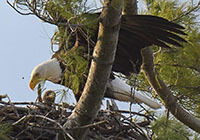 5/16 – Northeast Dutchess County: Bald eagle nest NY487 that we have dubbed the “Pine Tree Family,” was in its fourth year and had one nestling this spring. (Deborah Tracy Kral) 5/16 – Northeast Dutchess County: Bald eagle nest NY487 that we have dubbed the “Pine Tree Family,” was in its fourth year and had one nestling this spring. (Deborah Tracy Kral)
- Deborah Tracy Kral
 5/16 – Staatsburg, HRM 86: We were walking at Mills Norrie State Park, looking for migrating warblers, when we came upon an eastern box turtle on the forest floor. The turtle's shell (carapace) was eight-inches front-to-back, and it withdrew its extremities defensively as we approached. (David Lund photo) 5/16 – Staatsburg, HRM 86: We were walking at Mills Norrie State Park, looking for migrating warblers, when we came upon an eastern box turtle on the forest floor. The turtle's shell (carapace) was eight-inches front-to-back, and it withdrew its extremities defensively as we approached. (David Lund photo)
- David Lund, Linda Lund
5/16 – Town of Poughkeepsie: Bald eagle nest NY372 (Tombstone) had two nestlings and they were getting big! If our estimate on their hatch dates are correct, we may see fledges between June 1-19.
- Sheila Bogart
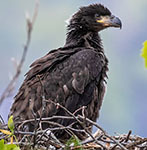 5/16 – Town of Poughkeepsie: The lone nestling in bald eagle nest NY62 was growing fast as well. If our estimates are accurate, the nestling should become a fledgling between June 2-20. (John Badura photo) 5/16 – Town of Poughkeepsie: The lone nestling in bald eagle nest NY62 was growing fast as well. If our estimates are accurate, the nestling should become a fledgling between June 2-20. (John Badura photo)
- Tom Lake
5/17 – Schuylerville, HRM 186: We visited Hudson Crossing today to search for warblers and had our best day there ever. Hudson Crossing staff had organized a two-day "Get to know Hudson Crossing" event, including a “Dog Easter Egg Hunt” (it was a very cool event for dogs). Even though we were not alone, our list of warblers was impressive, including American redstart, black-and-white, black-throated green, blackpoll, Cape May, chestnut-sided, common yellowthroat, Louisiana waterthrush, magnolia, Nashville, palm, northern parula, ovenbird, Tennessee, yellow, and yellow-rumped.
- Scott Varney, Heidi Nicholson (Hudson-Mohawk Bird Club)
5/17 – Athens, HRM 118: While kayaking this morning, I saw an osprey bring a fish to its mate who was on their nest on the Hudson anchorage day mark at the mouth of the North Bay. I was not sure if the bird on the nest ate the fish or was feeding a nestling. Later, on the way home, I came upon a seal with a large fish in its jaws. I was thrilled! I had never seen a seal here before. (I could not tell if it was a harbor seal or another type of seal.) It ate the fish and took off upriver.
- Michele Tarsa
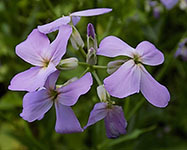 5/17 – Millbrook, HRM 82: One of the signs of the waning spring season is the appearance of Dame’s rocket (Hesperis matronalis) along upland roadsides and along the river and its tributaries. This naturalized wildflower, native to Eurasia and brought to North America in the 17th century, comes in white, pink, violet, and purple. Carried by spring breezes, its wonderfully sweet fragrance fills the air from mid-May through early June. (Tom Lake photo) 5/17 – Millbrook, HRM 82: One of the signs of the waning spring season is the appearance of Dame’s rocket (Hesperis matronalis) along upland roadsides and along the river and its tributaries. This naturalized wildflower, native to Eurasia and brought to North America in the 17th century, comes in white, pink, violet, and purple. Carried by spring breezes, its wonderfully sweet fragrance fills the air from mid-May through early June. (Tom Lake photo)
- Tom Lake, T.R. Jackson, B.J. Jackson
5/17 –Tenafly, NJ, HRM 17: We took an early morning bird walk in Greenbrook Sanctuary and found a fledgling great horned owl just off the path about head-high off the ground. We had spotted it four days ago in the same vicinity. We also had a good look at a singing worm-eating warbler, a veery, ovenbirds, a female American redstart, and a common yellowthroat.
Bob Rancan, Janet Rancan
5/18 – Saratoga County, HRM 182: In mid-afternoon, I found a huge flock of an estimated 300 white-winged scoters on Saratoga Lake. Viewing from Reilly’s Cove, I also spotted two dozen Bonaparte’s gulls, several common terns, five common loons, and five brant.
- Alan Mapes
 5/18 – Town of Wappinger: I love to stand stock-still downwind from a coyote and just watch their movements. I had that opportunity today at the edge of big grassy field. The coyote was very intent on hunting in the grass, likely for small mammals like mice and voles. Its movements were classic coyote: stop-start, stalking, tip-toeing, freezing with one paw raised, and then a pounce. 5/18 – Town of Wappinger: I love to stand stock-still downwind from a coyote and just watch their movements. I had that opportunity today at the edge of big grassy field. The coyote was very intent on hunting in the grass, likely for small mammals like mice and voles. Its movements were classic coyote: stop-start, stalking, tip-toeing, freezing with one paw raised, and then a pounce.
The eastern coyote’s fur varies from a natural heather-tan to occasional varieties of blonde, reddish, and charcoal. They are most easily noticed when they are in motion; when they stop, they blend in with the surroundings, invisible, motionless, dissolving into the muted background. (Melissa Fischer photo)
- Tom Lake
*** Fish of the Week ***
5/18 – Hudson River Watershed: Fishes-of-the-Week for Week 71 is the Atlantic menhaden (Brevoortia tyrannus) number 26 (of 230), on our Hudson River Watershed List of Fishes. If you would like a copy of our list, e-mail: trlake7@aol.com.
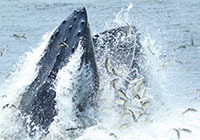 Atlantic menhaden are a herring (Clupeidae) and are classified for the estuary as a permanent - seasonally resident marine species. They spawn in salt to brackish water but adapt to the entire range of the river from full-strength seawater to freshwater. They occupy estuaries and coastal waters from northern Florida to Nova Scotia as planktivorous fishes, being very efficient filter feeders with specialized gill rakers that allows them to capture plankton. They support a huge commercial reduction fishery resulting in the production of fish meal, fish oil, as well as a bait fishery. Atlantic menhaden are a herring (Clupeidae) and are classified for the estuary as a permanent - seasonally resident marine species. They spawn in salt to brackish water but adapt to the entire range of the river from full-strength seawater to freshwater. They occupy estuaries and coastal waters from northern Florida to Nova Scotia as planktivorous fishes, being very efficient filter feeders with specialized gill rakers that allows them to capture plankton. They support a huge commercial reduction fishery resulting in the production of fish meal, fish oil, as well as a bait fishery.
They are known regionally with colloquial names such as bunker, mossbunker, and pogies. Their gorgeous silvery young-of-year, with a yellow-tinged caudal (tail) fin, are known colloquially as peanut bunker or penny bunker. The young-of-year are found by the many millions in the estuary in summer as they surge upriver—this may be an adaptation for survival; a small silvery fish in the clear Atlantic has a limited chance of survival—providing forage for osprey, eagles, seals, and whales. The estuary may also provide them with a more abundant supply of plankton.
Atlantic menhaden are the principle catalyst for extraordinary feeding frenzies through summer into autumn by bluefish and striped bass. In November 2016, an adult humpback whale cruised into the Upper Bay of New York Harbor fox six days. The whale ventured from the Verrazano Narrows to the East River to the George Washington Bridge feasting on Atlantic menhaden before returning to the open ocean. (Bjorn Kils photo)
- Tom Lake
5/19 – Annandale-on-Hudson, HRM 98.5: My visit to the tidewater Saw Kill was finally successful. I estimated 200 frenetic alewives in from the river, as well as numerous spawning events. They had ventured as far upstream as the first waterfall. The river herring identification came from one headless, tailless, fish that I suspected was the victim of a mink. However, I still have not seen any white suckers or other migratory fish, but the smallmouth bass were still there.
- Bob Schmidt
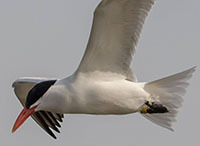 5/19 – Rondout Creek, HRM 91: I photographed a Caspian tern today that was carrying a leg band (K73). I sent the band data, gathered from a photograph, to the United States Geological Survey (USGS) for information on its origin. (Jim Yates photo) 5/19 – Rondout Creek, HRM 91: I photographed a Caspian tern today that was carrying a leg band (K73). I sent the band data, gathered from a photograph, to the United States Geological Survey (USGS) for information on its origin. (Jim Yates photo)
- Jim Yates
[Understanding animal behavior, including their travels, was very important to ecologist Aldo Leopold. In his classic work A Sand County Almanac (1949), Leopold proclaims that banding a bird is like “holding a ticket in a great lottery.” Tom Lake]
 5/19 – Ulster County: One of the two nestlings in bald eagle nest NY142 (Mount Saint Alphonsus) has been showing signs of restlessness indicating its eagerness to explore. We think this one hatched on March 11 and, if the average holds for a fledge date, this nestling might take its first flight between May 21 and June 8. The second nestling seems less robust and more docile so we suspect it was a later hatch. 5/19 – Ulster County: One of the two nestlings in bald eagle nest NY142 (Mount Saint Alphonsus) has been showing signs of restlessness indicating its eagerness to explore. We think this one hatched on March 11 and, if the average holds for a fledge date, this nestling might take its first flight between May 21 and June 8. The second nestling seems less robust and more docile so we suspect it was a later hatch.
This morning the eager nestling was boldly stretching its wings, "feeling the wind," and taking several hop-flaps around the nest moving laterally several feet at a time. Then, in the middle of the nest, it lifted off and briefly hovered several feet above the nest before lowering back down. With little delay, it spread its wings and lifted off again at least six feet in the air and maneuvering madly in the wind for five seconds—a mini-flight. A strong gust could have blown it overboard, but it managed another safe landing. I've been fortunate to see two First Flights (fledges) over the years, and it always strikes me as an amazing combination of trepidation and courage. (Mario Meier photo)
- Dave Lindemann
5/19 – Town of Poughkeepsie: The two adults at bald eagle nest NY62 were perched nearby but not in the nest. The lone nestling was up on the rim, standing tall, and you could almost sense by its body language that it wanted to know when the next food delivery would be coming.
- Tom Lake
[At many bald eagle nests, at some point between hatching and fledgling (72-90 days on average) the adults begin to lessen their time spent in the nest. The reason for this can be space: many nests have barely enough room for one or two nestlings, three nestlings can be a real challenge. The main reason, however, is the burgeoning, often incessant, appetites of the nestlings coupled with their near total lack of patience. They are truly immature. When the nestlings are nearing time to fledge, the adults will simply drop food from above and then go off and perch nearby. Getting in the nest with unruly, impatient, and often unforgiving nestlings becomes too dangerous. Tom Lake]
5/19 – Cornwall Landing, HRM 57: There are some Hudson River fishes that when you catch one, you will likely catch many. Banded killifish is one of those. Our seine filled with both male and female killifish today (48-54 millimeters (mm)), the former’s lavender highlights glistened in the sunlight, the latter’s drab colors were perfect for its role of concealment. The river was 63 degrees Fahrenheit (F).
- Tom Lake, Phyllis Lake
(1 inch = 25.4 millimeters (mm))
5/20 – Hudson Valley, HRM 90-145: Birders in Ulster, Dutchess, Greene, and Albany counties tracked what may have been the same flock of migrating brant flying up the Hudson River this evening. They were first observed flying over Sleightsburg (7:00 PM), then Clermont (7:40), then New Baltimore (8:20), then Colonie 9:00), roughly 70 miles in two hours. That would have them flying at roughly 35 mph.
- Rich Guthrie
5/20 – Ulster County: Both nestlings in bald eagle nest NY142 were active today. One was out on their main perch and the other was flapping around inside the nest “feeling its wings.” The adult male flew in with a meal, and the perched nestling did a wonderful side-stepping flap dance back along the limb to get his share. Both nestlings dove into their meal and were gone from sight.
- Mario Meier
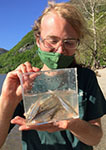 5/20 – Cold Spring, HRM 55: We hauled our seine in the shadow of Mount Taurus. Background sound was comprised of raven “gronks” and the hammering of a pileated woodpecker. We had hopes of catching something different, but the resident species dominated, including spottail shiners (86-112 mm) and tessellated darters. Many of the three dozen spottail shiners were gravid females with eggs. The river had warmed to 62 degrees F. (Phyllis Lake photo) 5/20 – Cold Spring, HRM 55: We hauled our seine in the shadow of Mount Taurus. Background sound was comprised of raven “gronks” and the hammering of a pileated woodpecker. We had hopes of catching something different, but the resident species dominated, including spottail shiners (86-112 mm) and tessellated darters. Many of the three dozen spottail shiners were gravid females with eggs. The river had warmed to 62 degrees F. (Phyllis Lake photo)
- David Hein, Lauren Martin, Phyllis Lake, Tom Lake
5/20 – Croton Point, HRM 35: I was surprised to see a mink crossing the dirt road on the south side of Croton Point where it fronts Croton Bay. The mink traveled from the Phragmites tidemarsh to the forest near the Underhill wine sellers. This was the first mink I had ever encountered here, although I have seen them along the banks of the Croton River that meets Croton Bay just east of Croton Point.
- Jim Miller
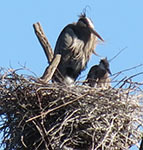 5/20 – Bedford, HRM 35: I counted five nestling at the great blue heron rookery today. Other nestlings may have been hidden in the nests so it was too soon to determine how many there were. There were still at least two nests where herons could be seen incubating. The osprey that was here last week had left. It was most likely just investigating a nest that was abandoned a few weeks earlier. (Jim Steck photo) 5/20 – Bedford, HRM 35: I counted five nestling at the great blue heron rookery today. Other nestlings may have been hidden in the nests so it was too soon to determine how many there were. There were still at least two nests where herons could be seen incubating. The osprey that was here last week had left. It was most likely just investigating a nest that was abandoned a few weeks earlier. (Jim Steck photo)
- Jim Steck
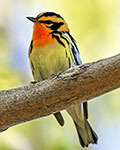 5/21 – Saratoga County, HRM 157: This morning I walked the usual three-mile western loop at the Vischer Ferry Nature Preserve plus a short stretch east on the towpath. Long overdue for me was the first least bittern of the season, calling frequently from the edge of the West Pond. I also heard a Virginia rail calling. 5/21 – Saratoga County, HRM 157: This morning I walked the usual three-mile western loop at the Vischer Ferry Nature Preserve plus a short stretch east on the towpath. Long overdue for me was the first least bittern of the season, calling frequently from the edge of the West Pond. I also heard a Virginia rail calling.
The three common warblers that breed at the preserve were well-represented—yellow, common yellowthroat, and American redstart—but the other warblers that pass through quickly were very scarce. I detected just a Canada warbler, a chestnut-sided warbler, and a Blackburnian warbler. Even the northern waterthrushes were quiet this morning. A few other species present included eastern wood-pewee, willow flycatcher, least flycatcher, great crested flycatcher, eastern kingbird, yellow-throated vireo, marsh wren, blue-gray gnatcatcher, wood thrush, veery, cedar waxwing, and scarlet tanager. (Deborah Tracy Kral photo)
- John Hershey (Hudson-Mohawk Bird Club)
5/21 – Rondout Creek, HRM 91: I received the origin banding data from the United States Geological Survey (USGS) today on the Caspian tern I photographed on May 19.
The Caspian tern (K73) was banded by Katherine Yard, NYSDEC Wildlife Diversity Program, on June 22, 2017, at Hounsfield, Jefferson County, near the Sant Lawrence River. Katherine made a note that the tern “was too young to fly” when banded. After 1,064 days, the tern had arrived at a point 240 miles southeast of where it was banded. It would be interesting to know where it had traveled in the interim. The banding effort is a collaborative program of the Canadian Wildlife Service, the USGS, and the NYSDEC.
- Jim Yates
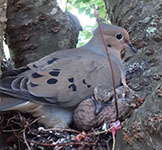 5/21 – Staatsburg, HRM 86: What a treat we had today at our mourning dove nest. Both not-so-little nestlings came out under Mom's wings and flew gently to the ground under our crabapple tree. I could hear them practicing their coos that ended close to an octave higher than Mom’s. So special! (Joanne Engle photo) 5/21 – Staatsburg, HRM 86: What a treat we had today at our mourning dove nest. Both not-so-little nestlings came out under Mom's wings and flew gently to the ground under our crabapple tree. I could hear them practicing their coos that ended close to an octave higher than Mom’s. So special! (Joanne Engle photo)
- Joanne Engle
5/21 – Poughkeepsie, HRM 74: A report came in today from a local commercial riverman who was drifting his herring net down the river in pursuit of bait for future blue crab fishing. Mixed in his catch, with alewives and blueback herring, were adult (13-14-inches) Atlantic menhaden, a saltwater herring. In the decades of the 20th century, when the river was dotted with floats in the spring under which hung shad nets, the arrival of menhaden, or “bunker”, from the Tappan Zee to Poughkeepsie, signaled that it was time to stow our gear for another season—the American shad season was over. Today the water was 60 degrees F.
- Tom Lake
 5/21 – Cold Spring, HRM 55: I was along the river this morning just before first light until just after sunrise. It was cold. The air temperature had fallen to freezing overnight but that did not deter the wildlife: As I walked through the forest, I heard the sounds of what seemed like a thousand voices all trying to be heard. Most I could not recognize–they tended to run over each other–but the thrushes, catbirds and others were there. I heard a variety of warblers and flycatchers but without seeing them, I had no clue. The one exception was an olive-sided flycatcher ("Quick, three beers!") that I learned after many springtime mornings on the river. 5/21 – Cold Spring, HRM 55: I was along the river this morning just before first light until just after sunrise. It was cold. The air temperature had fallen to freezing overnight but that did not deter the wildlife: As I walked through the forest, I heard the sounds of what seemed like a thousand voices all trying to be heard. Most I could not recognize–they tended to run over each other–but the thrushes, catbirds and others were there. I heard a variety of warblers and flycatchers but without seeing them, I had no clue. The one exception was an olive-sided flycatcher ("Quick, three beers!") that I learned after many springtime mornings on the river.
Down to the water we had gear to check and nets to haul. Finally, we caught what we were looking for: river herring, in this instance alewives (Alosa pseudoharengus). They glistened in the sunlight, their scales like shiny new dimes. These were adults fresh in from the sea, headed upriver to whatever tributary they may have imprinted on as young-of-year four years ago. The roe (females) were solid with eggs (293-295 mm); the bucks (males) were silvery sleek (264-267 mm). The river temperature had dropped six degrees overnight to 56 degrees F. (Tom Lake photo)
- Tom Lake, A. Danforth
5/22 – Correction: Our 5/15 entry reporting the presence of an endangered bog turtle (Glyptemys muhlenbergii) in Saugerties, was discovered, upon closer review, to be a different species, and not a bog turtle.
- Alvin Breisch
5/22 – Beacon, HRM 61: We never saw the actual pickup, but we did see the splash as an adult bald eagle lost its grip and dropped a large fish back into the river. It is not rare for an eagle to have aspirations that exceed its ability to perform. Carrying a large fish is commonly one of those. Within a half hour, the eddy current of the dropping tide had the wounded fish drifting inshore close enough to wade out and collect. It was a 24-inch female channel catfish, heavy with roe. In hefting it, I guessed it was all of 5 pounds. Although we worked the fish back in the water, the four-inch-long deep gash on its abdomen from the eagle’s talons had slimed its chances of surviving. As a footnote to the day, we caught tessellated darters and spottail shiners in our net. The river was 64 degrees F.
- Tom Lake, Phyllis Lake
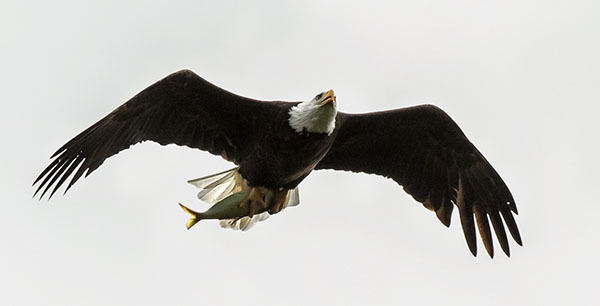
Spring 2020 Natural History Programs
- TBA
DEC advises New Yorkers to take measures to reduce bear conflicts
State Department of Environmental Conservation (DEC) Commissioner Basil Seggos reminds New Yorkers to take steps to reduce conflicts with bears. Feeding bears either intentionally, which is illegal, or unintentionally through careless practices around properties, has consequences for entire communities. DEC advises everyone who lives in or visits bear habitat, which is much of Upstate New York, to remove items that are attractive to bears. People should take down bird feeders by April 1, store garbage inside secure buildings, and feed pets indoors. These actions are necessary to live responsibly with black bears, protect people, property, and bears. For more information about how to reduce human/bear conflicts, visit DEC's website.
Guidelines on how to avoid problems with black bears: http://www.dec.ny.gov/press/113258.html
DEC Announces Changes to 2020 Striped Bass Fishing Regulations
State Adopts New Recreational and Commercial Slot Size Limits
The New York State Department of Environmental Conservation (DEC) has adopted new regulations for recreational and commercial fishing for Atlantic striped bass. These regulations, which take effect immediately, are to reduce state commercial and recreational harvests by 18 percent as required by the Atlantic States Marine Fisheries Commission (ASMFC). Recreational striped bass seasons start on April 1 in the Hudson River and tributaries and on April 15 in marine waters. Anglers are encouraged to use circle hooks in 2020 when using bait.
For more information on fishing, visit DEC’s website: https://www.dec.ny.gov/outdoor/fishing.html
Editor's Note: In last week's Almanac, the boundary for marine waters was incorrectly defined as south of the Mario M. Cuomo (Tappan Zee) Bridge. The correct boundary for these regulations is south of the George Washington Bridge. We apologize for any confusion this may have caused.
New York State Striped Bass Recreational Angling Regulations (updated 2020)
• In marine waters – (south of the George Washington Bridge)
Slot size limit: 28" - 35" total length (No fish smaller than 28" or greater than 35" may be kept)
Season date: April 15 - December 15
Daily possession limit of 1 fish/angler
• In the Hudson River and tributaries
Slot size limit: 18"- 28" total length (No fish smaller than 18" or greater than 28" may be kept)
Season date: April 1 - November 30
Daily possession limit of 1 fish/angler
DEC Seeks Birdwatchers to contribute to 2020 Breeding Bird Atlas
State Department of Environmental Conservation (DEC) Commissioner Basil Seggos has announced a call for citizen-science volunteers to help in the development of a comprehensive, statewide survey that takes place every two decades to detail New York’s breeding bird distribution. Starting in 2020, five years of field surveys will be conducted by volunteers and project partners to provide the data that will be analyzed to create the third New York State Breeding Bird Atlas.
“Just as New Yorkers are embarking on the 2020 Census to track human populations and trends, DEC and our partners track our natural populations to evaluate the effectiveness of New York’s programs and initiatives to promote diverse and healthy wildlife,” Commissioner Seggos said. “The Breeding Bird Atlas is a valuable tool to help protect birds and habitat, and I encourage all New Yorkers to get outdoors safely and responsibly and participate in this year’s survey while practicing social distancing.”
DEC is partnering with the New York Natural Heritage Program, SUNY College of Environmental Science and Forestry (ESF), Audubon New York, Cornell Lab of Ornithology, New York State Ornithological Association, and New York Cooperative Fish and Wildlife Research Unit on this project. When complete, the atlas will provide species-specific details about distribution, maps, and illustrations.
The last atlas was published in 2008, with information on its results available on DEC’s website. Five years of fieldwork by more than 1,200 contributors provided the data for the second addition to New York’s understanding of the state’s avifauna (birds). This substantial book revealed striking changes in the distributions of many of our breeding birds since New York's first Breeding Bird Atlas was published in 1988. Data showed that half of New York’s 253 species showed a significant change in their distribution, with 70 species showing increases and 58 species showing declines. A comparison study between the first two atlases showed that the distribution of 129 species moved northward an average of 3.58 kilometers due to climate change. The 2020 atlas will provide further data on this shift and climate change’s potential impact on wildlife.
To participate, volunteers can make a free eBird account and submit data online through the atlas website (ebird.org/atlasny) or via the eBird mobile app. Simply record the species and any breeding behaviors observed. All sightings can count. As observations are reported, data can be viewed here: https://ebird.org/atlasny/state/US-NY.
Hudson River Miles
The Hudson is measured north from Hudson River Mile 0 at the Battery at the southern tip of Manhattan. The George Washington Bridge is at HRM 12, the Tappan Zee 28, Bear Mountain 47, Beacon-Newburgh 62, Mid-Hudson 75, Kingston-Rhinecliff 95, Rip Van Winkle 114, and the Federal Dam at Troy, the head of tidewater, at 153. The tidal section of the Hudson constitutes a bit less than half the total distance – 315 miles – from Lake Tear of the Clouds to the Battery. Entries from points east and west in the watershed reference the corresponding river mile on the mainstem.
To Contribute Your Observations or to Subscribe
The Hudson River Almanac is compiled and edited by Tom Lake and emailed weekly by DEC's Hudson River Estuary Program. Share your observations by e-mailing them to trlake7@aol.com.
To subscribe to the Almanac (or to unsubscribe), use the links on DEC's Hudson River Almanac or DEC Delivers web pages.
Discover New York State
The Conservationist, the award-winning, advertisement-free magazine focusing on New York State's great outdoors and natural resources. The Conservationist features stunning photography, informative articles and around-the-state coverage. Visit The Conservationist webpage for more information.
Useful Links
National Oceanic and Atmospheric Administration online tide and tidal current predictions are invaluable when planning Hudson River field trips.
For real-time information on Hudson River tides, weather and water conditions from sixteen monitoring stations, visit the Hudson River Environmental Conditions Observing System website.
DEC's Smartphone app for iPhone and Android is now available at: New York Fishing, Hunting & Wildlife App.
NY's Outdoors Are Open
#RecreateLocal-- Safely and Responsibly
DEC and Office of Parks, Recreation and Historic Preservation (State Parks) are encouraging New Yorkers to engage in responsible recreation during the ongoing COVID-19 public health crisis. DEC and State Parks recommendations incorporate guidance from the Centers for Disease Control and Prevention and the New York State Department of Health for reducing the spread of infectious diseases and encourage New Yorkers to recreate locally, practice physical distancing, and use common sense to protect themselves and others. In addition, DEC and State Parks launched a new hashtag-#RecreateLocal-and encourage New Yorkers to get outside and discover open spaces and parks close to home.
Information about the Hudson River Estuary Program is available on DEC's website at http://www.dec.ny.gov/lands/4920.html.
|


 5/17 – Black Creek, HRM 85: A beautiful afternoon paddle in the mouth of Black Creek uncovered a glimpse of the larger creatures that call the Hudson home. The parade started with an osprey streaking overhead, wings cocked in a fast dive that pulled up into flapping frustration at me—the invasive kayaker. That set off a splash and something big streaking through the low-tide shallows throwing a big wake. I followed the trail of underwater mud puffs until a beaver showed just under the surface, steadily cruising. It was so much bigger and bulkier than I expected. A “splash!” surprised me, and when I turned my head expecting a beaver tail slap, instead it was a carp launching out of the water. Ten big carp streamed by in a squadron, each limned in scales and fins. Then fifteen, twenty, in groups of three and four; thirty, forty… incredible! Osprey, beaver, carp: so much biomass. Think of how many photons of light on bits of green chlorophyll it took to create the bark and leaves and plankton and critters that ultimately assembled in these creatures. Just awesome. (Deborah Tracy Kral photo)
5/17 – Black Creek, HRM 85: A beautiful afternoon paddle in the mouth of Black Creek uncovered a glimpse of the larger creatures that call the Hudson home. The parade started with an osprey streaking overhead, wings cocked in a fast dive that pulled up into flapping frustration at me—the invasive kayaker. That set off a splash and something big streaking through the low-tide shallows throwing a big wake. I followed the trail of underwater mud puffs until a beaver showed just under the surface, steadily cruising. It was so much bigger and bulkier than I expected. A “splash!” surprised me, and when I turned my head expecting a beaver tail slap, instead it was a carp launching out of the water. Ten big carp streamed by in a squadron, each limned in scales and fins. Then fifteen, twenty, in groups of three and four; thirty, forty… incredible! Osprey, beaver, carp: so much biomass. Think of how many photons of light on bits of green chlorophyll it took to create the bark and leaves and plankton and critters that ultimately assembled in these creatures. Just awesome. (Deborah Tracy Kral photo) 5/16 – Northeast Dutchess County: Bald eagle nest NY487 that we have dubbed the “Pine Tree Family,” was in its fourth year and had one nestling this spring. (Deborah Tracy Kral)
5/16 – Northeast Dutchess County: Bald eagle nest NY487 that we have dubbed the “Pine Tree Family,” was in its fourth year and had one nestling this spring. (Deborah Tracy Kral) 5/16 – Staatsburg, HRM 86: We were walking at Mills Norrie State Park, looking for migrating warblers, when we came upon an eastern box turtle on the forest floor. The turtle's shell (carapace) was eight-inches front-to-back, and it withdrew its extremities defensively as we approached. (David Lund photo)
5/16 – Staatsburg, HRM 86: We were walking at Mills Norrie State Park, looking for migrating warblers, when we came upon an eastern box turtle on the forest floor. The turtle's shell (carapace) was eight-inches front-to-back, and it withdrew its extremities defensively as we approached. (David Lund photo) 5/16 – Town of Poughkeepsie: The lone nestling in bald eagle nest NY62 was growing fast as well. If our estimates are accurate, the nestling should become a fledgling between June 2-20. (John Badura photo)
5/16 – Town of Poughkeepsie: The lone nestling in bald eagle nest NY62 was growing fast as well. If our estimates are accurate, the nestling should become a fledgling between June 2-20. (John Badura photo) 5/17 – Millbrook, HRM 82: One of the signs of the waning spring season is the appearance of Dame’s rocket (Hesperis matronalis) along upland roadsides and along the river and its tributaries. This naturalized wildflower, native to Eurasia and brought to North America in the 17th century, comes in white, pink, violet, and purple. Carried by spring breezes, its wonderfully sweet fragrance fills the air from mid-May through early June. (Tom Lake photo)
5/17 – Millbrook, HRM 82: One of the signs of the waning spring season is the appearance of Dame’s rocket (Hesperis matronalis) along upland roadsides and along the river and its tributaries. This naturalized wildflower, native to Eurasia and brought to North America in the 17th century, comes in white, pink, violet, and purple. Carried by spring breezes, its wonderfully sweet fragrance fills the air from mid-May through early June. (Tom Lake photo) 5/18 – Town of Wappinger: I love to stand stock-still downwind from a coyote and just watch their movements. I had that opportunity today at the edge of big grassy field. The coyote was very intent on hunting in the grass, likely for small mammals like mice and voles. Its movements were classic coyote: stop-start, stalking, tip-toeing, freezing with one paw raised, and then a pounce.
5/18 – Town of Wappinger: I love to stand stock-still downwind from a coyote and just watch their movements. I had that opportunity today at the edge of big grassy field. The coyote was very intent on hunting in the grass, likely for small mammals like mice and voles. Its movements were classic coyote: stop-start, stalking, tip-toeing, freezing with one paw raised, and then a pounce. Atlantic menhaden are a herring (Clupeidae) and are classified for the estuary as a permanent - seasonally resident marine species. They spawn in salt to brackish water but adapt to the entire range of the river from full-strength seawater to freshwater. They occupy estuaries and coastal waters from northern Florida to Nova Scotia as planktivorous fishes, being very efficient filter feeders with specialized gill rakers that allows them to capture plankton. They support a huge commercial reduction fishery resulting in the production of fish meal, fish oil, as well as a bait fishery.
Atlantic menhaden are a herring (Clupeidae) and are classified for the estuary as a permanent - seasonally resident marine species. They spawn in salt to brackish water but adapt to the entire range of the river from full-strength seawater to freshwater. They occupy estuaries and coastal waters from northern Florida to Nova Scotia as planktivorous fishes, being very efficient filter feeders with specialized gill rakers that allows them to capture plankton. They support a huge commercial reduction fishery resulting in the production of fish meal, fish oil, as well as a bait fishery. 5/19 – Rondout Creek, HRM 91: I photographed a Caspian tern today that was carrying a leg band (K73). I sent the band data, gathered from a photograph, to the United States Geological Survey (USGS) for information on its origin. (Jim Yates photo)
5/19 – Rondout Creek, HRM 91: I photographed a Caspian tern today that was carrying a leg band (K73). I sent the band data, gathered from a photograph, to the United States Geological Survey (USGS) for information on its origin. (Jim Yates photo) 5/19 – Ulster County: One of the two nestlings in bald eagle nest NY142 (Mount Saint Alphonsus) has been showing signs of restlessness indicating its eagerness to explore. We think this one hatched on March 11 and, if the average holds for a fledge date, this nestling might take its first flight between May 21 and June 8. The second nestling seems less robust and more docile so we suspect it was a later hatch.
5/19 – Ulster County: One of the two nestlings in bald eagle nest NY142 (Mount Saint Alphonsus) has been showing signs of restlessness indicating its eagerness to explore. We think this one hatched on March 11 and, if the average holds for a fledge date, this nestling might take its first flight between May 21 and June 8. The second nestling seems less robust and more docile so we suspect it was a later hatch. 5/20 – Cold Spring, HRM 55: We hauled our seine in the shadow of Mount Taurus. Background sound was comprised of raven “gronks” and the hammering of a pileated woodpecker. We had hopes of catching something different, but the resident species dominated, including spottail shiners (86-112 mm) and tessellated darters. Many of the three dozen spottail shiners were gravid females with eggs. The river had warmed to 62 degrees F. (Phyllis Lake photo)
5/20 – Cold Spring, HRM 55: We hauled our seine in the shadow of Mount Taurus. Background sound was comprised of raven “gronks” and the hammering of a pileated woodpecker. We had hopes of catching something different, but the resident species dominated, including spottail shiners (86-112 mm) and tessellated darters. Many of the three dozen spottail shiners were gravid females with eggs. The river had warmed to 62 degrees F. (Phyllis Lake photo) 5/20 – Bedford, HRM 35: I counted five nestling at the great blue heron rookery today. Other nestlings may have been hidden in the nests so it was too soon to determine how many there were. There were still at least two nests where herons could be seen incubating. The osprey that was here last week had left. It was most likely just investigating a nest that was abandoned a few weeks earlier. (Jim Steck photo)
5/20 – Bedford, HRM 35: I counted five nestling at the great blue heron rookery today. Other nestlings may have been hidden in the nests so it was too soon to determine how many there were. There were still at least two nests where herons could be seen incubating. The osprey that was here last week had left. It was most likely just investigating a nest that was abandoned a few weeks earlier. (Jim Steck photo) 5/21 – Saratoga County, HRM 157: This morning I walked the usual three-mile western loop at the Vischer Ferry Nature Preserve plus a short stretch east on the towpath. Long overdue for me was the first least bittern of the season, calling frequently from the edge of the West Pond. I also heard a Virginia rail calling.
5/21 – Saratoga County, HRM 157: This morning I walked the usual three-mile western loop at the Vischer Ferry Nature Preserve plus a short stretch east on the towpath. Long overdue for me was the first least bittern of the season, calling frequently from the edge of the West Pond. I also heard a Virginia rail calling. 5/21 – Staatsburg, HRM 86: What a treat we had today at our mourning dove nest. Both not-so-little nestlings came out under Mom's wings and flew gently to the ground under our crabapple tree. I could hear them practicing their coos that ended close to an octave higher than Mom’s. So special! (Joanne Engle photo)
5/21 – Staatsburg, HRM 86: What a treat we had today at our mourning dove nest. Both not-so-little nestlings came out under Mom's wings and flew gently to the ground under our crabapple tree. I could hear them practicing their coos that ended close to an octave higher than Mom’s. So special! (Joanne Engle photo) 5/21 – Cold Spring, HRM 55: I was along the river this morning just before first light until just after sunrise. It was cold. The air temperature had fallen to freezing overnight but that did not deter the wildlife: As I walked through the forest, I heard the sounds of what seemed like a thousand voices all trying to be heard. Most I could not recognize–they tended to run over each other–but the thrushes, catbirds and others were there. I heard a variety of warblers and flycatchers but without seeing them, I had no clue. The one exception was an olive-sided flycatcher ("Quick, three beers!") that I learned after many springtime mornings on the river.
5/21 – Cold Spring, HRM 55: I was along the river this morning just before first light until just after sunrise. It was cold. The air temperature had fallen to freezing overnight but that did not deter the wildlife: As I walked through the forest, I heard the sounds of what seemed like a thousand voices all trying to be heard. Most I could not recognize–they tended to run over each other–but the thrushes, catbirds and others were there. I heard a variety of warblers and flycatchers but without seeing them, I had no clue. The one exception was an olive-sided flycatcher ("Quick, three beers!") that I learned after many springtime mornings on the river.